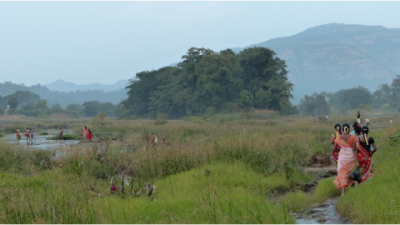
Researchers from IIT Bombay find evidence of high potential geothermal systems existing on the west coast of Maharashtra
During my visit to my grandma’s place near Aravali in the Konkan region of Maharashtra, a trip to the closest hot spring was a routine. The spring acted as the source of hot water to the locals, and the water was said to have medicinal properties. Thermal springs, such as this, are a part of the geothermal fluids that occur below the surface of the earth to depths of about a kilometre. In a recent study, Dr Trupti Chandrashekhar from the Indian Institute of Technology Bombay (IIT Bombay), and her collaborators from the Indian Institute of Technology Hyderabad, Rajiv Gandhi Institute of Petroleum Technology, Amethi, and other institutes from Italy, have explored the origins of the hot springs along the Western Ghats. They have found that these springs evolved from rocks millions of years old, and marine sediments played a crucial role in their evolution.
There is more to the hot springs than just the famous spas around them. Geothermal fluids, in general, are used in aquaculture, horticulture, space heating and power generation. “Geothermal fluids act as the source and feedstock for geothermal power plants, just like coal for a coal power plant, or wind for a wind power plant. India has an immense potential for geothermal resource development and has the potential to generate over 10,000 MW of power using geothermal resources,” says Dr Chandrashekhar. The quality, quantity, temperature, pressure and grading of these fluids decide the type of geothermal power plants that can be built.
What forms geothermal fluids? Surface water on earth percolates deeper through faults and fissures in the rocks. As the temperature rises gradually below the surface, this water is subjected to heat and pressure and finds its way out to the surface again through faults in the rocks, in the form of geysers and springs. Depending on the path of circulation and the rocks it interacts with, the water obtains specific chemical properties that are characteristic of its evolution and origin.
Geothermal fluids contain a wide variety of dissolved constituents including carbonates, nitrates, zinc, copper and boron. By studying these constituents, scientists decipher the fundamental processes like water-rock interactions, the origin of thermal fluids and also the environmental impacts of their exploitation.
The Deccan plateau, formed millions of years ago as a result of volcanic activity, has a layer of basalt on the top with varying thickness. Basalt is a type of rock of volcanic origin. Below this are sedimentary layers of sandstone, called the Kadalgi sediments. Underneath them are rocks formed billions of years ago, called the Precambrian granite and gneiss. Long tectonic faults in the Deccan volcanic flows run in the north-south direction in the Konkan region of Maharashtra, almost parallel to the west coast. The springs in places like Sativli, Mandangad, Aravali, Anjaneri, Rajapur and others, form a cluster of hot springs found in these rock formations.
“The geothermal springs along the western coast of Maharashtra flow along linear faults that lie parallel to the west coast. They formed about 65 million years ago when the whole of western India experienced intense volcanic activity,” explains Dr Chandrashekhar.
The researchers of this study collected 15 thermal springs water samples, eight groundwater samples and two river water samples along a 350 km stretch. They then studied the chemical composition, temperature, salinity and electrical conductivity of the samples to understand the ascent of thermal fluids. They also studied rock and water interactions in the laboratory, at high temperature and pressure, to simulate the reaction of rock and water deep inside the earth. The researchers also carried out an investigation on the boron isotopes for the first time on Indian thermal springs.
The study found that the Deccan basalts, the Kaladgi sediments, and the Precambrian granites play a significant role in the evolution of the thermal springs along the west coast. The chemical analysis of elements like calcium, sodium and chlorine, and the boron isotope studies, indicated that the geothermal water from all these places, except those at Rajapur and Math, originated from locations that were influenced by marine sediments deposited millions of years ago.
The study points to a possibility of geothermal power project development in Maharashtra and proposes splitting it into short-term, mid-term and long-term plans. The short-term plan could focus on uses like space heating, dehydration units for perishable food products, aquaculture or natural health spas, which could promote sustainable small to medium enterprise businesses. “Mid and long-term development plan could be centred around the use of geothermal energy for generating cheap, clean and base power generation systems, beginning with the drilling of ten to fifteen deep exploration along the identified locations,” concludes Dr Chandrashekhar
